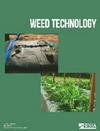模拟除草剂施用失败后的水稻稗草(Echinochloa crus-galli)防治救治措施
IF 1.7
3区 农林科学
Q3 AGRONOMY
引用次数: 0
摘要
Florpyrauxifen-benzyl于2018年实现商业化,主要针对稗草和水生或阔叶杂草。2019 年至 2021 年,在密歇根州斯通维尔市进行了田间研究,以评估氟吡禾草灵苄基除草剂或其他常见水稻芽后(POST)除草剂模拟失效后的稗草防除效果。在第一项田间研究中,在水稻二至三叶期施用 0 和 15 g ai ha-1 的氟吡禾草灵,以模拟针对稗草的施用失败。连续除草剂处理包括不施用除草剂,以及在氟吡甲禾灵-苄处理后 7 或 14 天施用全剂量的吡唑醚菌酯、喹草酮、双嘧-Na 和氰氟草酯。第二项田间研究的目的是在模拟水稻后期除草剂失效后,评估氟吡禾草灵苄基除草剂对稗草的控制效果。最初的除草剂处理包括不使用除草剂和使用一半剂量的吡唑醚菌酯、喹草酮、双嘧菌酯-Na 和丙草胺。在初始除草剂处理后 7 或 14 天连续施用的除草剂包括 0 和 30 g ai ha-1 的氟噻草胺苄酯。第一项研究的结果表明,与初始处理(DA-I)后 14 天未施用氟吡禾草灵相比,最终处理(DAFT)后 21 天的稗草控制率更高。因此,在首次施用 15 克/公顷的氟噻草胺苄草后 14 天再进行连续处理,会使稗草长得过大,无法用其他水稻除草剂控制。在施用喹草酮的时间从 7 DA-I 延迟到 14 DA-I 但没有施用氟吡甲禾灵苄基禾本科除草剂的地块,糙米产量降低。第二项研究建议,在除草剂失效后 14 d 再施用氟吡禾草灵-苄。虽然在使用任何除草剂的 7 天或 14 天后施用氟噻草胺苄对稗草 21 DAFT 的控制效果没有差异,但只有在 14 天后施用氟噻草胺苄才能达到 85% 的控制效果。这些结果证明了在模拟施用普通水稻除草剂失败后的稗草控制方案。本文章由计算机程序翻译,如有差异,请以英文原文为准。
Salvage Treatments for Barnyardgrass (Echinochloa crus-galli) Control in Rice Following Simulated Failed Herbicide Application
Florpyrauxifen-benzyl was commercialized in 2018 to target barnyardgrass and aquatic or broadleaf weeds. Field studies were conducted from 2019 to 2021 in Stoneville, MS, to evaluate barnyardgrass control following a simulated failure of florpyrauxifen-benzyl or other common postemergence (POST) rice herbicides. In the first field study, florpyrauxifen-benzyl was applied at 0 and 15 g ai ha-1 to rice at the two- to three-leaf stage to simulate a failed application targeting barnyardgrass. Sequential herbicide treatments included no herbicide and full rates of imazethapyr, quinclorac, bispyribac-Na, and cyhalofop applied 7 or 14 d after florpyrauxifen-benzyl treatment. The second field study was designed to evaluate barnyardgrass control with florpyrauxifen-benzyl following simulated failure of POST rice herbicides. Initial herbicide treatments included no herbicide and half rates of imazethapyr, quinclorac, bispyribac-Na, and propanil. Sequential applications at 7 or 14 d after the initial herbicide treatments included florpyrauxifen-benzyl at 0 and 30 g ai ha-1 . Results from the first study indicated barnyardgrass control 21 d after final treatment (DAFT) was greater with sequential treatments at 7 compared with 14 d after initial treatment (DA-I) with no initial application of florpyrauxifen-benzyl. Therefore, delaying sequential treatments until 14 d after initial florpyrauxifen-benzyl at 15 g ha-1 allowed barnyardgrass to become too large to control with other rice herbicides. Rough rice yield was reduced in plots where quinclorac application was delayed from 7 to 14 DA-I with no initial application of florpyrauxifen-benzyl. The second study suggested that florpyrauxifen-benzyl application should be delayed 14 d after a herbicide failure. While no differences in barnyardgrass control 21 DAFT were detected whether florpyrauxifen-benzyl was applied 7 or 14 DA-I of any herbicide utilized, >85% control was only achieved when florpyrauxifen-benzyl application was delayed 14 DA-I. These results demonstrate barnyardgrass control options following simulated failed applications of common rice herbicides.
求助全文
通过发布文献求助,成功后即可免费获取论文全文。
去求助
来源期刊

Weed Technology
农林科学-农艺学
CiteScore
2.90
自引率
21.40%
发文量
89
审稿时长
12-24 weeks
期刊介绍:
Weed Technology publishes original research and scholarship in the form of peer-reviewed articles focused on understanding how weeds are managed.
The journal focuses on:
- Applied aspects concerning the management of weeds in agricultural systems
- Herbicides used to manage undesired vegetation, weed biology and control
- Weed/crop management systems
- Reports of new weed problems
-New technologies for weed management and special articles emphasizing technology transfer to improve weed control
-Articles dealing with plant growth regulators and management of undesired plant growth may also be accepted, provided there is clear relevance to weed science technology, e.g., turfgrass or woody plant management along rights-of-way, vegetation management in forest, aquatic, or other non-crop situations.
-Surveys, education, and extension topics related to weeds will also be considered
 求助内容:
求助内容: 应助结果提醒方式:
应助结果提醒方式:


